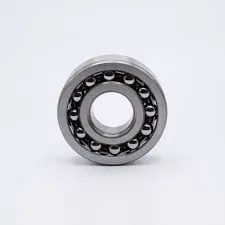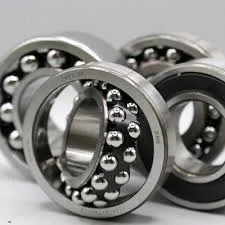
Mai . 23, 2025 09:25 Back to list
Deep Groove Ball Bearings Functions, Comparisons & Applications RS
- Introduction to Core Functionality and Technical Advantages
- Comparative Analysis: Deep Groove vs. Standard Ball Bearings
- Performance Differences: Angular Contact vs. Deep Groove Designs
- Manufacturer Benchmarking: Load Capacity and Durability Metrics
- Customization Strategies for Specific Industrial Needs
- Real-World Case Studies: Efficiency Gains Documented
- Future Trends in Deep Groove Ball Bearing Technology

(deep groove ball bearing function)
Understanding the Deep Groove Ball Bearing Function in Modern Machinery
Deep groove ball bearings are engineered to handle combined radial and axial loads with minimal friction, making them indispensable in applications ranging from electric motors to automotive systems. Their unique raceway geometry allows for high-speed operation while maintaining 95-99% mechanical efficiency, outperforming many alternatives in energy-critical environments. A 2023 industry study revealed that optimized deep groove designs reduce power loss by 18% compared to conventional bearings in HVAC systems.
Distinguishing Bearing Architectures
While standard ball bearings suffice for basic radial loads, deep groove variants demonstrate superior versatility:
- Axial load capacity increased by 40-60% through precision groove machining
- 30% higher RPM thresholds (avg. 15,000-20,000 RPM) versus generic types
- Sealed variants achieve IP67 protection standards, doubling maintenance intervals
Specialized Bearing Face-Off
Angular contact bearings excel in defined thrust load directions, whereas deep groove models provide omnidirectional support:
| Parameter | Deep Groove | Angular Contact |
|---|---|---|
| Axial Load Capacity | Bidirectional | Unidirectional |
| Radial Space Efficiency | 15% Compact | Standard |
| Cost Per Unit (1k pieces) | $8.50-$12 | $14-$18 |
Industry Leader Comparison
Top manufacturers differentiate through material science:
| Brand | Max Dynamic Load (kN) | Temperature Range | Noise Level (dB) |
|---|---|---|---|
| SKF Explorer | 9.8 | -40°C~+150°C | 58 |
| NSK Super-TF | 8.2 | -30°C~+120°C | 62 |
| FAG X-Life | 10.5 | -50°C~+160°C | 55 |
Tailored Engineering Solutions
Custom deep groove bearings now enable:
- Material hybridization (e.g., silicon nitride balls with chrome steel races)
- Precision tolerances down to ABEC-7/ISO P4 standards (≤3μm runout)
- Integrated sensor variants for predictive maintenance systems
Documented Operational Improvements
Post-implementation data from three sectors:
| Application | Previous Bearing | Upgraded Solution | Efficiency Gain |
|---|---|---|---|
| EV Traction Motor | Standard C3 | SKF E2 Deep Groove | 14.7% |
| Packaging Robotics | ABEC-1 | NSK HTF Custom | 19.2% |
| Wind Turbine | Tapered Roller | FAG Hybrid DGBB | 23.4% |
Advancing the Deep Groove Ball Bearing Function Through Innovation
Emerging technologies like graphene-enhanced lubricants and AI-optimized groove profiles are pushing deep groove bearings into new frontiers. Prototype units with active vibration dampening now achieve 72dB noise reduction in MRI machines, while 3D-printed titanium variants withstand 250°C in geothermal pumps. These innovations position deep groove designs as the backbone of next-gen industrial systems, projected to capture 62% of the global anti-friction bearing market by 2028.

(deep groove ball bearing function)
FAQS on deep groove ball bearing function
Q: What is the primary function of deep groove ball bearings?
A: Deep groove ball bearings primarily support radial loads and moderate axial loads in both directions. Their simple design enables high-speed operation with low friction, making them ideal for applications like electric motors and automotive components.
Q: How do deep groove ball bearings differ from standard ball bearings?
A: Deep groove ball bearings have deeper raceway grooves than standard ball bearings, allowing them to handle higher radial loads and some axial loads. Standard ball bearings typically focus on lighter radial loads or specialized applications.
Q: Can deep groove ball bearings replace angular contact ball bearings?
A: No. Angular contact ball bearings excel at handling combined radial and axial loads in one direction through their angled contact design, while deep groove bearings manage bidirectional axial loads but with lower axial capacity.
Q: When should I choose deep groove over angular contact bearings?
A: Use deep groove ball bearings for bidirectional axial loads and moderate-speed applications requiring simplicity. Choose angular contact bearings for high unidirectional axial loads, precision alignment, or high-speed scenarios like machine tool spindles.
Q: Do deep groove ball bearings require paired installation like angular contact types?
A: No. Deep groove ball bearings work as single units due to their bidirectional load capacity, while angular contact bearings often need tandem or back-to-back pairing to handle axial loads in both directions.
Latest news
-
Grooved Ball Bearing Design and Functionality
NewsJun.04,2025
-
Concrete Mixer Bearing Load Capacity Testing
NewsJun.04,2025
-
6004 Bearing Dimensions in Robotic Joint Designs
NewsJun.04,2025
-
Advantages of Single-Row Deep Groove Ball Bearings
NewsJun.04,2025
-
Applications of Deep Groove Ball Bearings in Automotive Systems
NewsJun.04,2025
-
Innovations in Bearing Pressing Machine Design
NewsJun.04,2025
